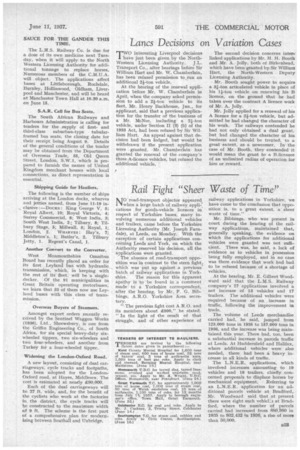Rail Fight 'Sheer Waste of Time"
Page 39

If you've noticed an error in this article please click here to report it so we can fix it.
KTO 'road-transport objector appeared, I when a large batch of railway applij cations for goods-vehicle licences in respect of Yorkshire bases, many involving numerous additional vehicles and trailers, came before the Yorkshire Licensing Authority (Mr. Joseph Farndale), at Leeds, on Monday. With the exception of certain applications concerning Leeds and York, on which the Authority reserved his decision, all the applications were granted.
The absence of road-transport opposition was' in contrast to the stern fight). which was put up against a previous batch of railway applications in York
shire, The reason for this apparent apathy is to be found in a comment made to a Yorkshire correspondent, after the hearing, by Mr. F. G. Bibbings, A.R.O. Yorkshire Area secretary.
" The previous fight cost A.R.O. and its members about £500," he stated. " In the light of the result of that struggle, and of other experience of railway applications in Yorkshire, we have come to the conclusion that opposition. is, to a great extent, a sheer waste of time."
Mr. Bibbings, who was present in court during the hearing of the railway applications, maintained that, generally speaking, the evidence on which the applications for additional vehicles were granted was not sufficient. There was, he said, a lack of evidence as to vehicles in possession being fully employed, and in no case was there evidence that work had had to be refused because 'of a shortage of vehicles.
At the hearing, Mr. E. Gilbert WoodWard said that the L.M.S. Railway company's 27 applications involved a net increase of 13 vehicles and 17 trailers. The additional vehicles were -required because of an increase in traffic, following the improvement in trade.
The volume of Leeds merchandise carried had,. he said, jumped from 123,000 tons in 1935 to 157,000 tons in 1936, and the increase was being maintained this year. There had, too, been a substantial increase in parcels traffic at Leeds. At Huddersfield and Halifax, where additional vehicles were also needed, there, had been a heavy increase in all kinds of traffic.
The L.N.E,R, applications, which involved increases amounting to 19 vehicles and 18 trailers, chiefly concerned proposals to displace horses by mechanical equipment. Referring to an L.N.E.R. application for an additional parcels vehicle at Bradford, Mr. Woodward said that at present there were eight such vehicks at Bradford, where the number of parcels carried had increased from 880,980 in 1935 to 932,432 in 1936, a rise of more than 50,060.






























































































